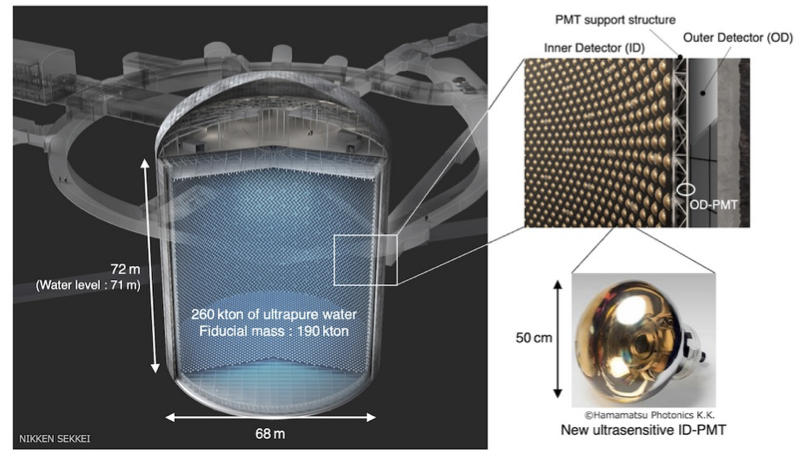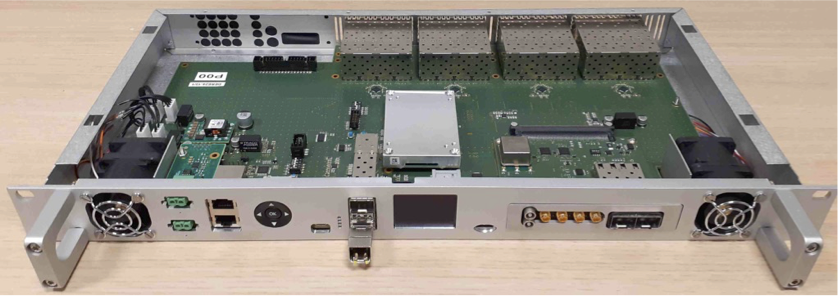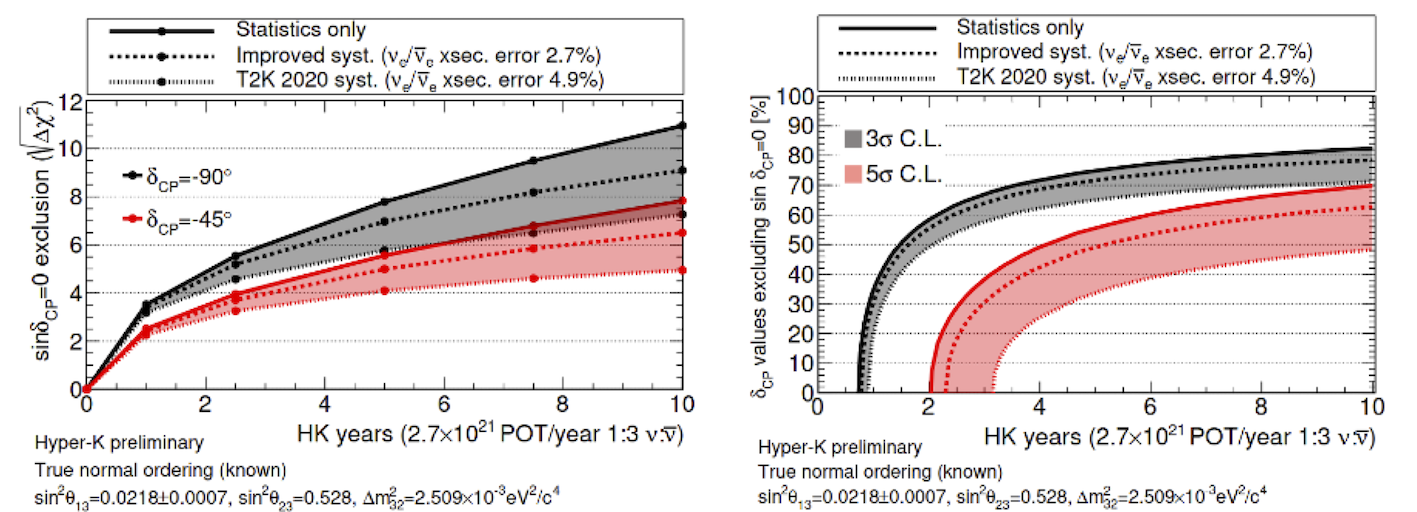Follow us on Google News (click on ☆)
The universe is filled with matter, while antimatter is very rare. The predominance of matter allowed complex structures, such as galaxies, stars, planets, and ultimately us, to form and exist as we observe them today. The Big Bang created the same amount of matter and antimatter: every particle should therefore have annihilated with a corresponding antiparticle to fill the Universe with light (photons) and nothing else.

Figure 1: Is the symmetry between neutrino and antineutrino oscillations broken?
Credit: APS/Carin Cain
A small asymmetry between matter and antimatter is necessary to avoid this catastrophic end. A very enigmatic particle, the neutrino, could hold the key to this mystery.
The neutrino is the least known particle in the Standard Model. One of the few things we know about it is that neutrinos must exist in at least three flavors (electron, muon, and tau) and that these states "oscillate" as neutrinos propagate through space and time. More precisely, neutrinos are created in interactions of other Standard Model particles in a definite flavor state, but they propagate in definite mass states, which correspond to linear combinations (quantum superpositions) of flavor states.
Consequently, a neutrino of a given energy created in a given flavor state has a well-defined probability of being detected in a different flavor state after traveling a given distance. This phenomenon is only possible if neutrinos are massive particles, contrary to what the Standard Model predicts.
Very interestingly, this phenomenon opens up the possibility for a new source of matter-antimatter asymmetry in the Universe: if neutrinos and antineutrinos (their antiparticles) oscillate differently, they could have played a crucial role in the mechanism responsible for the strong predominance of matter in the Universe.
From T2K to Hyper-Kamiokande
Neutrino oscillations were discovered in the late 1990s and awarded the Nobel Prize in Physics in 2015. Since then, oscillations have been studied in various experiments, notably using neutrinos produced by cosmic rays, the Sun, nuclear reactors, and particle accelerators. The latter have the unique ability to produce a beam of neutrinos or antineutrinos with optimized flavor and energy in the desired direction.

Figure 2: Schematic view of the far detector of Hyper-Kamiokande under construction in Japan.
Credit: Hyper-K collaboration
A set of detectors, placed near the neutrino source, is used to characterize the number of neutrinos produced and their probability of interacting with matter. A large "far" detector intercepts the neutrinos hundreds of kilometers from the source to measure the probability of oscillation from one flavor to another. This approach is currently used by the Tokai to Kamioka (T2K) experiment in Japan, to which Irfu makes crucial contributions.
T2K will operate until 2027, when its successor, Hyper-Kamiokande (HK), will take over. HK will have a neutrino beam more than twice as intense and a far detector more than eight times larger than that of T2K. HK will inherit the upgraded T2K near detector (ND280).
Thanks to the considerable increase in the statistics of neutrinos produced and detected, HK will be able to discover the possible asymmetry between neutrino and antineutrino oscillation, and provide new answers to the great mystery of matter-antimatter asymmetry in the Universe.
Hyper-Kamiokande@Irfu
Irfu is at the forefront of this major experimental effort and has already played a leading role in the redesign of the ND280 detector. The institute is now contributing to the construction of HK's new far detector. The major challenges for this new detector are related to its size: a cylindrical tank 72 meters (236 feet) high and 68 meters (223 feet) in diameter containing 260 kilotons of water (see figure 2), where the Cherenkov light produced by charged particles from neutrino interactions will be collected by approximately 13,000 photomultiplier tubes (PMTs). The signals from the PMTs will be read by more than a thousand electronic boards.

Figure 3: Prototype of the electronic module developed at Irfu for the first stage of the clock distribution system for the HK far detector. The module has 32 optical ports and has been optimized for deterministic latency with low instability (a few picoseconds).
To enable precise oscillation measurements, all readout units of this gigantic detector must be properly time-synchronized and inter-calibrated in energy to ensure the uniformity of their response. Irfu is at the heart of these challenges and is notably developing a new electronic module for the clock distribution system to the thousands of readout units. Irfu, through its branch at CERN, is also supporting the development of the test bench that will be used to precisely calibrate the electronic readout units and ensure they meet specifications.
To illustrate the technological challenge we face, we need to achieve an accuracy in the neutrino energy scale on the order of 0.5%, which imposes a requirement of 0.1% on the charge linearity calibration of the readout electronic boards.
Furthermore, to ensure a spatial resolution better than 15 cm (6 inches) for Cherenkov light paths of 100 meters (328 feet), a distribution system capable of sending a clock with a temporal stability better than 100 ps to 13,000 PMTs distributed over a cylindrical surface of more than 15,000 square meters (161,459 square feet) must be implemented. To this end, a multi-stage approach is being implemented, and Irfu is developing the first stage of this system: the new electronic module illustrated in figure 3 exhibits a random (deterministic) instability of less than 4ps (2ps).

Figure 4: The Hyper-Kamiokande detector will be placed 600 meters (1968 feet) underground in the Kamioka mine in Hida City, Gifu, where the largest cavern ever excavated by humans is being dug (left). The PMTs are being procured and tested before their installation (right).
The construction of the HK detector is underway. As shown in figure 4, the excavation of the cavern and the procurement of PMTs are well advanced. The data-taking phase is expected to begin in early 2028.
Hyper-Kamiokande's sensitivity to the oscillation asymmetry between neutrinos and antineutrinos
Irfu is also leading the main analysis effort to accurately estimate the sensitivity of the HK experiment for oscillation measurements and, in particular, for the discovery of a possible asymmetry between neutrino and antineutrino oscillation (see figure 5).
Recent T2K results indicate a very large neutrino-antineutrino asymmetry, in which case HK can definitively conclude the existence of this asymmetry in about 2 years of data-taking (at 5 standard deviations). In figure 5, the impact of systematic uncertainties on the oscillation measurements is also estimated, quantifying the crucial role of the ND280 near detector in enabling such an important discovery.
Indeed, to measure neutrino oscillations accurately, the probability of neutrino interaction with matter in the detector must be correctly modeled. Irfu has significantly contributed to the development of nuclear physics models for neutrino interactions and is a major contributor to their direct measurements using ND280 data.

Figure 5: Left, discovery potential (in number of standard deviations) for the asymmetry between neutrino and antineutrino oscillation as a function of the number of years of data-taking in HK. Two different values of the δCP parameter, which parameterizes the asymmetry, are tested: -90° corresponds to the maximum asymmetry, as indicated by preliminary T2K results, -45° corresponds to a 50% asymmetry. Right, fraction of the δCP parameter values for which HK can discover the asymmetry at 5 (or 3) standard deviations, as a function of the number of years of data-taking.
In summary, thanks to its crucial contribution to the HK near and far detectors, its unique expertise in nuclear physics, and its leading role in neutrino oscillation analysis, Irfu will be an essential player in HK's future discoveries.